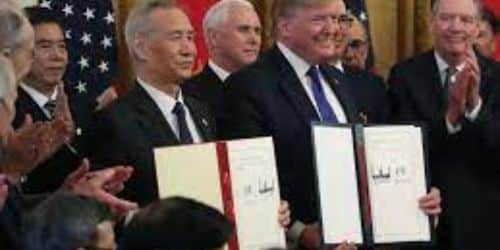In the ever-evolving landscape of global trade, navigating through trade wars can be complex and challenging. Trade wars can arise when countries impose tariffs and trade barriers on each other’s goods, impacting businesses, consumers, and economies worldwide. By understanding the dynamics of the US-China trade war and learning from past trade war examples in history, you can gain valuable insights into their implications and potential strategies to mitigate risks. In this article, we will guide you through the intricacies of trade wars, with a particular focus on the US-China trade war and historical precedents.
What is Trade War?
A trade war is a conflict between two or more countries characterized by imposing tariffs, trade barriers, or restrictions on each other’s imports and exports. These actions are taken in retaliation or to protect domestic industries and can have significant economic implications globally. Trade wars often arise when countries disagree over trade policies, unfair trade practices, or market access issues, leading to a breakdown in international trade relations. The imposition of tariffs and other trade barriers can disrupt supply chains, increase the cost of goods for consumers, and affect businesses’ profitability, making trade wars a complex and contentious issue in international economics and politics.
Us China Trade War
The US-China trade war started in July 2018 with the US imposing tariffs on Chinese goods, leading to retaliatory tariffs from China. This has caused higher costs for businesses and consumers, disrupted supply chains, and impacted various industries. The trade conflict has far-reaching implications for both countries and the global economy.
As the trade war continued, negotiations between the US and China took place intermittently to reach a trade agreement. Temporary truces and tariff reductions have occurred, but fundamental issues like market access, intellectual property rights, and state subsidies persist. The ongoing trade tensions have created uncertainty in international trade. However, leading businesses to reconsider their supply chain strategies and investment decisions. Moreover, the trade war has also strained diplomatic relations between the two countries and has become a significant geopolitical issue. The US-China trade war has become a defining feature of international trade in recent years, and its impact continues to be closely watched by policymakers, businesses, and investors worldwide.
Trade War in History
Trade wars in history have often emerged as a result of protectionist measures taken by countries to safeguard their domestic industries or to gain a competitive edge in international trade. One notable example is the Smoot-Hawley Tariff Act, enacted by the United States in 1930 during the Great Depression. This act significantly raised import duties, leading to retaliatory actions by other countries, exacerbating the economic downturn and contributing to a global recession.
In recent years, trade tensions between the US and China created a prominent global economic feature. The trade war involved tariffs and trade barriers, leading to supply chain disruptions and higher costs for businesses. This has caused uncertainty in financial markets and far-reaching effects on industries and consumers worldwide.
Trade wars have perceived benefits like protecting domestic industries, but they also bring significant disadvantages. Increased tariffs and trade barriers can reduce international trade, harming global businesses and causing job losses. Additionally, trade wars can strain diplomatic relations between countries, creating tensions that may extend beyond economic issues.
Trade wars are complex and have multifaceted impacts on the global economy. They underscore the delicate balance between economic growth and the risks associated with protectionism. Understanding the historical context and consequences of trade wars can help policymakers make informed decisions to promote more sustainable and cooperative international trade relationships.
Read also: FLOOR TRADERS: Everything You Should Know
What Is an Example of a Trade War?
One of the biggest and most damaging trade confrontations in recent memory is the one between the United States and China. It all began when the Trump administration in the United States imposed tariffs on several products from China, alleging difficulties with intellectual property theft and unfair trade practices. China responded by placing taxes on American products in retaliation, starting a trade war that has lasted for years.
The global trade environment and economy have both been significantly impacted by this trade war. As the two biggest economies in the world, their activities have had a profound effect on the financial markets, supply networks, and a wide range of businesses. Business decisions regarding investments and international trade relations have been impacted by trade disputes. In addition, consumers have noticed higher pricing for imported items as a result of the levies.
International organizations and other nations have also reviewed their trade relations and policies in response to the trade war. Concerns about the possible dangers of protectionism and its effects on the world economy have been voiced by many states.
The U.S.-China trade war is still an open subject, and its long-term effects are still unclear despite ongoing negotiations and brief ceasefires. It serves as a harsh reminder of how trade disputes can worsen and affect numerous nations on a global scale.
Read: PUBLICLY TRADED COMPANIES: Definition, 2023 List & All You Needlso read:
Why Did the Trade War With China Start?
The trade war with China began in 2018 when the Trump administration put tariffs on a variety of Chinese imports. The fundamental causes for the trade war’s start were concerns about China’s unfair trade practices, such as intellectual property theft and forced technology transfers from American companies operating in China. Furthermore, the US wished to rectify the two nations’ trade imbalance, as China exported significantly more commodities to the US than the US exported to China.
Furthermore, the US accused China of subsidized sectors and currency manipulation to obtain an unfair advantage in international commerce. These actions were seen negatively by American corporations and employees, resulting in tensions between the two economic titans. Both countries slapped retaliatory tariffs on each other’s goods, impacting many industries and increasing uncertainty in global markets.
The trade war with China affected not only bilateral economic relations but also had broader ramifications for the global economy. Tariffs caused supply chain disruptions and cost increases for many global corporations. The prolonged trade conflict had repercussions for the economies of other nations as they became involved in navigating the intricate economic dynamics between the United States and China.
Trade tensions eased slightly in 2020 when the United States and China inked a phase one trade agreement aimed at addressing some of the issues highlighted during the trade war. However, certain differences persisted, and the two countries’ commercial relationship is still being negotiated and scrutinized. The trade war with China was a watershed moment in international trade dynamics, raising discussions about trade policies and the future of globalization.
Which Two Countries Are in a Trade War?
The trade war mostly involved the United States and China. However, trade conflicts and tensions between countries can shift according to geopolitical changes and policy decisions. To comprehend the most recent trade trends, it is critical to stay up to date on current developments.
Who Started the Trade War?
When the United States, under President Donald Trump’s administration, placed tariffs on several Chinese products, a trade war between the two countries broke out. The decision was made because American companies and the economy were being harmed by China’s unfair trade practices, such as intellectual property theft and forced technology transfer. China’s answer was to retaliate by placing taxes on American products, which increased tensions between the two nations. Both economies have been significantly impacted by the trade war, with consumers paying more for some products. Also making businesses incur higher expenditures. The trade disagreement has been trying to be resolved through negotiations, but the situation is still complex and ambiguous. The trade war is still a major problem in international relations. It has significant effects on trade and economic stability on a worldwide scale.
Who Won the Trade War With China?
There is no clear winner in the trade conflict between the United States and China at this time. The dispute has resulted in economic difficulties for both nations, and the impact on international trade and the global economy remains uncertain. Certain industries may have benefited from the tariffs, but overall, the trade conflict has been detrimental to businesses and consumers in both nations. Continued efforts are being made to reach a comprehensive trade agreement, but the situation remains complicated and unresolved. As the trade war continues to develop, the ultimate victor will be determined by its long-term effects on the global economy.
Read: Balance of Trade (BOT): Definition, Components, and Calculations
What are the Advantages and Disadvantages of a Trade War?
Advantages
- Protecting domestic industries and jobs from foreign competition.
- They are reducing trade deficits and increasing domestic production.
- Encouraging domestic innovation and investment in key industries.
Disadvantages
- Higher costs for consumers due to increased tariffs on imported goods.
- Retaliation from other countries led to a decrease in global trade.
- Disruption in supply chains and potential job losses in export-oriented industries.
FAQs
What exactly is the US-China trade war?
A serious trade battle between the United States and China began in 2018-19. The US placed duties on approximately $350 billion in Chinese imports. China replied by imposing levies on an additional $100 billion in imports, a retaliatory step permitted under WTO regulations.
What are the consequences of a trade war?
Trade warfares stifle international trade in products and services. Because of the reduced competition, they raise the prices of local items. It causes the global economy to stall and domestic inflation to rise.
When did the United States begin trading with China?
The Treaty of Wanghia, signed in 1844, was the first trade agreement between the United States and China. It codified the two countries’ growing connections, granted additional privileges to American entrepreneurs in China, and paved the way for new commercial and cultural contacts.
Related Articles
- WHAT ARE TARIFFS: Meaning & How Do They Affect Your Business?
- 4 ways to exit the price war.
- Trading Apps: Definition, Types Examples.
- BEST DENTAL INSURANCE PLANS: Best Plans For Individuals And Seniors
- THE BUSINESS CYCLE: How to Measure It, and Its Phases






